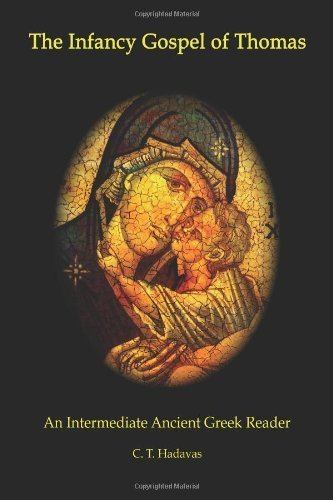 | ||
Similar Gospel of James, Gospel of Peter, Gospel of Thomas, Gospel of Philip, Gospel of Mary | ||
The Infancy Gospel of Thomas is a pseudepigraphical gospel about the childhood of Jesus that is believed to date to the 2nd century. It was part of a popular genre of biblical work, written to satisfy a hunger among early Christians for more miraculous and anecdotal stories of the childhood of Jesus than the Gospel of Luke provided. Later references by Hippolytus of Rome and Origen of Alexandria to a "Gospel of Thomas" are more likely to be referring to this Infancy Gospel than to the wholly different Gospel of Thomas with which it is sometimes confused. It would appear to be unrelated to the Canonical Gospels.
Contents
- The infancy gospel of thomas and james 2 14 26
- Author
- Dating
- Manuscript tradition
- Content
- Syriac Infancy Gospel
- References
The infancy gospel of thomas and james 2 14 26
Author
The Infancy Gospel of Thomas is a work attributed to "Thomas the Israelite" (in a medieval Latin version). The biblical Thomas (or Judas Thomas, Didymos Judas Thomas, etc.) is very unlikely to have had anything to do with the text. Some scholars believe the initial author was a gentile, and whomever he was, he seems not to have known much of Jewish life besides what he could learn from the Gospel of Luke, which the text seems to refer to directly in ch. 19; Sabbath and Passover observances are mentioned.
Dating
The first known quotation of its text is from Irenaeus of Lyon, ca 185. The earliest possible date of authorship is in the 80s A.D., the approximate date of the Gospel of Luke, from which the author of the Infancy Gospel borrowed the story of Jesus in the temple at age twelve (see Infancy 19:1-12 and Luke 2:41-52). Scholars generally agree on a date in the mid- to late-2nd century A.D. There are two 2nd-century documents, the Epistula Apostolorum and Irenaeus' Adversus haereses, which refer to a story of Jesus' tutor telling him, "Say beta," and him replying, "First tell me the meaning of alpha." It is generally agreed that there was at least some period of oral transmission of the text, either wholly or as several different stories before it was first redacted and transcribed, and it is thus entirely possible that both of these documents and the Infancy Gospel of Thomas all refer to the oral versions of this story.
Manuscript tradition
It is unknown whether the original language of the Infancy Gospel of Thomas was Greek or Syriac. The few surviving Greek manuscripts provide no clues themselves, since none of them date before the 13th century, while the earliest authorities, according to the editor and translator Montague Rhodes James, are a much abbreviated 6th century Syriac version, and a Latin palimpsest of the 5th or 6th century, which has never been fully translated and can be found in Vienna. There are many different manuscripts, translations, shortened versions, alternates, and parallels with slight nuance differences. James found that their large number makes the accounting of which text was which very difficult. This number of texts and versions reflects the great popularity of the work during the High Middle Ages.
Content
The text describes the life of the child Jesus, with fanciful, and sometimes malevolent, supernatural events, comparable to the trickster nature of the god-child in many a Greek myth. One of the episodes involves Jesus making clay birds, which he then proceeds to bring to life, an act also attributed to Jesus in Quran 5:110, although Jesus's age at the time of the event is not specified in the Quran. In another episode, a child disperses water that Jesus has collected. Jesus kills his first child, when at age one he curses a boy, which causes the child's body to wither into a corpse. Later, Jesus kills another child when Jesus curses him when he apparently accidentally bumps into Jesus, throws a stone at Jesus, or punches Jesus (depending on the translation).
When Joseph and Mary's neighbors complain, they are miraculously struck blind by Jesus. Jesus then starts receiving lessons, but arrogantly tries to teach the teacher instead, upsetting the teacher who suspects supernatural origins. Jesus is amused by this suspicion, which he confirms, and revokes all his earlier apparent cruelty. Subsequently he resurrects a friend who is killed when he falls from a roof, and heals another who cuts his foot with an axe.
After various other demonstrations of supernatural ability, new teachers try to teach Jesus, but he proceeds to explain the law to them instead. There is another set of miracles in which Jesus heals his brother who is bitten by a snake, and two others who have died from different causes. Finally, the text recounts the episode in Luke in which Jesus, aged twelve, teaches in the temple.
Although the miracles seem quite randomly inserted into the text, there are three miracles before, and three after, each of the sets of lessons. The structure of the story is essentially:
Episodes from Jesus' childhood as depicted in the "Klosterneuburger Evangelienwerk", a 14th-century gospel translation:
Syriac Infancy Gospel
The Syriac Infancy Gospel (Injilu 't Tufuliyyah), translated from a Coptic original, gives some parallels to the episodes "recorded in the book of Josephus the Chief Priest, who was in the time of Christ."
